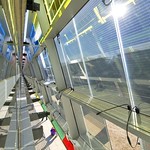World Cities Day (31th of October)
On World Cities Day, COMSA Corporation wants to highlight different projects in which its R & D & I department is currently working. Its commitment to research and applied development allows it to offer its clients technological solutions to advance their needs and improve the efficiency of their actions, including those for the construction of buildings that are to shape the cities of the future, also called smart cities, which not only make efficient use of resources but also consider the responsible use of energy.
In this sense, COMSA Corporation is developing the GEOTECH project, a hybrid air conditioning system based on geothermal energy with the objective of installing it using the foundations of the buildings. Geothermal energy is a renewable energy that uses the thermal stability of the soil to heat the heat to the building by means of a heat pump, with the differential characteristic of providing both cold and heat without substantial variations between day and night conditions Environmental or time of year. This method will reduce overall energy consumption in the building.
Likewise, to combat air pollution, COMSA Corporación is developing self-cleaning photocatalytic coatings that do not require maintenance. The project is based on the incorporation of particles on the glass panels of buildings, technically known as TiO2, which in contact with sunlight favour the degradation of airborne contaminants such as carbon dioxide or hydrocarbons.
In recent years, photovoltaic energy is being positioned as a clean and competitive energy, whose use allows the buildings to be more sustainable, so that COMSA Corporation is also focusing its research in this area. Currently, the MIDNATTSSOL project is being carried out, which aims to create a system to detect in real time surpluses of photovoltaic energy and thus maximize the use of solar energy in the air conditioning of the installation.
On the other hand, the SOLPROCEL project focuses on the development of semi-transparent organic photovoltaic cells with photonic crystals. These cells, integrated on windows and glass facades of buildings and facilities, improve energy efficiency thanks to its high level of transparency and energy collection. This technology can be very useful for the construction of sustainable buildings by introducing energy self-consumption, as well as reducing the bill of those already existing facilities with an intensive use of energy. This innovation was recently presented at the ‘OPV Workshop: A new technology to market’ held in Barcelona.
